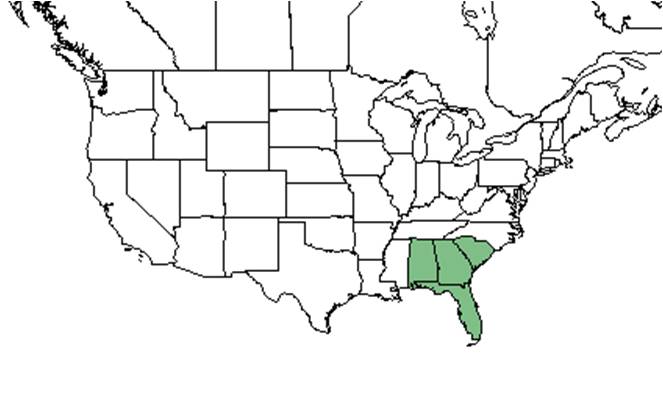Oclemena reticulata
| Oclemena reticulata | |
|---|---|

| |
| Photo by Betty Wargo, Atlas of Florida Vascular Plants | |
| Scientific classification | |
| Kingdom: | Plantae |
| Division: | Magnoliophyta - Flowering plants |
| Class: | Magnoliopsida – Dicotyledons |
| Order: | Asterales |
| Family: | Asteraceae ⁄ Compositae |
| Genus: | Oclemena |
| Species: | O. reticulata |
| Binomial name | |
| Oclemena reticulata (Pursh) G.L. Nesom | |

| |
| Natural range of Oclemena reticulata from USDA NRCS Plants Database. | |
Common name: Pine barren whitetop aster
Contents
Taxonomic notes
Synonyms: Aster reticulatus Pursh; Doellingeria reticulata (Pursh) Greene
Description
A description of Oclemena reticulata is provided in The Flora of North America.
It is distinct from other Oclemena by having tall erect stems, leaves with undulate margins, and late spring blooming.[1]
Distribution
Distributed from South Carolina to Florida and southern Alabama.[1]
Ecology
Habitat
O. reticulata can be found in areas that are occasionally inudated during the summer rainy season [2]. In the Coastal Plain in Florida and Georgia, habitats include wet pine flatwoods, pine/saw palmetto flatwoods, oak/palmetto scrubs, boggy wiregrass pine flatwoods, and ecotones between cypress swamps and pine flatwoods.It can be found in disturbed areas such as powerline corridors, cutover wet pinewoods and pasture edges. Soil types include loamy sand, sandy peat, and sandy loam. [3] O. reticulata does not respond to soil disturbance by clearcutting and chopping in North Florida flatwoods forests.[4]
Associated species include Sphagnum, Pinus serotina, Serenoa repens, Lyonia lucida, Rhynchospora, Cyperus haspan, C. strigosus, Eragrostis atrovirens, Ilex glabra, Lachnanthes caroliniana, Osmunda cinnamomea, Panicum abscisum, Pinus elliottii, Pteridium aquilinum, Rubus argutus, and Smilax laurifolia. [3] [5]
Phenology
O. reticulata has been observed flowering in January and from April to September and fruits have been observed March through October.[3][6] It can spread by rhizomes and quickly form extensive colonies [2].
Fire ecology
It has been observed growing in prescribed burned wet flatwoods and a burn zone in mesic flatwoods. [5]
Pollination
The following Hymenoptera families and species were observed visiting flowers of Oclemena reticulata at Archbold Biological Station: [7]
Apidae: Apis mellifera
Megachilidae: Dianthidium floridiense
Conservation and management
Global status: G4G5
Last Reviewed: May 2, 1988[8].
Cultivation and restoration
Photo Gallery
Flowers of Oclemena reticulata Photo by Wayne Matchett, SpaceCoastWildflowers.com
References and notes
- ↑ 1.0 1.1 [[1]] University of Waterloo. Accessed: February 11, 2016
- ↑ 2.0 2.1 [[2]] Native Florida Wildflowers Accessed February 10, 2016
- ↑ 3.0 3.1 3.2 Florida State University Robert K. Godfrey Herbarium database. URL: http://herbarium.bio.fsu.edu. Last accessed: October 2015. Collectors: Loran C. Anderson, Andre F. Clewell, George R. Cooley, R.F. Doren, Bob Fewster, A. Gholson Jr., R.K. Godfrey, Norlan C. Henderson, S.C. Hood, C. Jackson, Nancy E. Jordan, M. Knott, R. Komarek, Robert Kral, S.W. Leonard, Sidney McDaniel, Marc Minno, Grady W. Reinert, J. Semple, Cecil R. Slaughter, Joe Sparling, L.B. Trott, Kenneth A. Wilson, Carroll E. Wood. States and Counties: Florida: Bradford, Calhoun, Clay, Columbia, Duval, Flagler, Franklin, Gulf, Hamilton, Hardee, Hernando, Highlands, Hillsborough, Holmes, Jackson, Lake, Leon, Liberty, Nassau, Orange, Osceola, Pasco, Pinellas, Polk, Putnam, St. Johns, Taylor, Union, Wakulla, Walton. Georgia: Thomas. Compiled by Tall Timbers Research Station and Land Conservancy.
- ↑ Moore, W.H., B.F. Swindel, and W.S. Terry. (1982). Vegetative Response to Clearcutting and Chopping in a North Florida Flatwoods Forest. Journal of Range Management 35(2):214-218.
- ↑ 5.0 5.1 University of Florida Herbarium. URL: [3]. Last accessed: February 2016. Collectors: L.M. Baltzell, Edwin L. Bridges, Paul Corogin, Caroline Easley, Doug Goldman, David Hall, Cathleen Kabat, Steven Kabat, M.S. Morris, Kurt M. Neubig, Steve L. Orzell. States and Counties: Florida: Alachua, Brevard, Clay, DeSoto, Hernando, Lake, Manatee, Nassau, Pasco, Polk, Sumter, Union, Volusia. Compiled by Tall Timbers Research Station and Land Conservancy.
- ↑ Nelson, G. PanFlora: Plant data for the eastern United States with emphasis on the Southeastern Coastal Plains, Florida, and the Florida Panhandle. www.gilnelson.com/PanFlora/ Accessed: 12 DEC 2016
- ↑ Deyrup, M.A. and N.D. 2015. Database of observations of Hymenoptera visitations to flowers of plants on Archbold Biological Station, Florida, USA.
- ↑ [[4]] NatureServe. Accessed February 12, 2016
